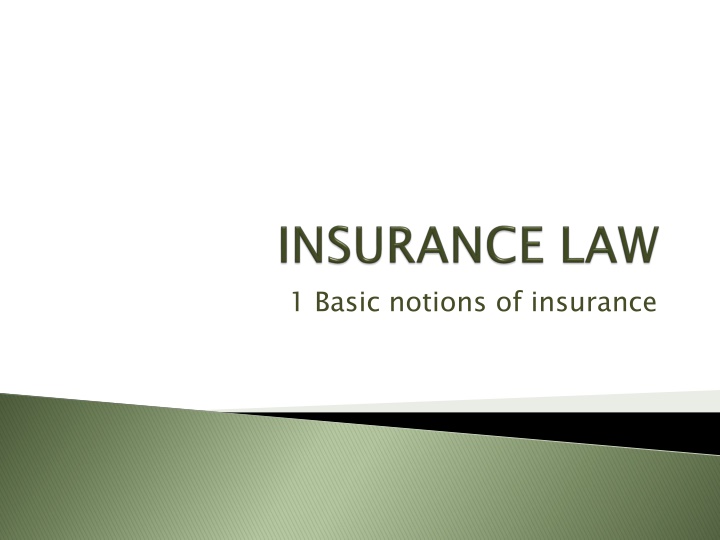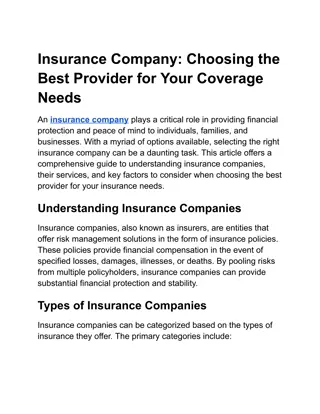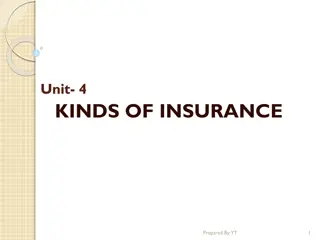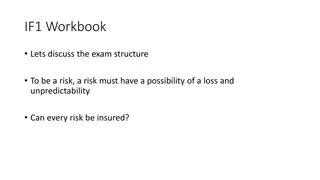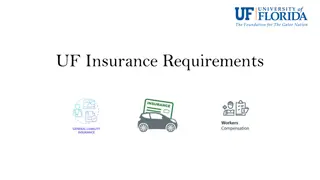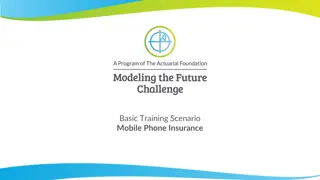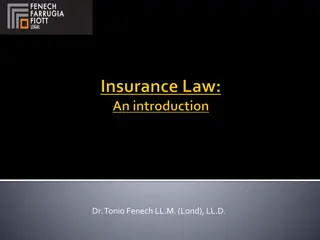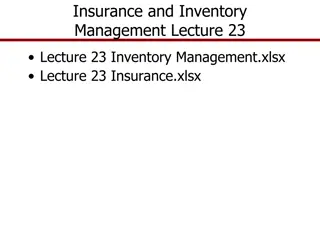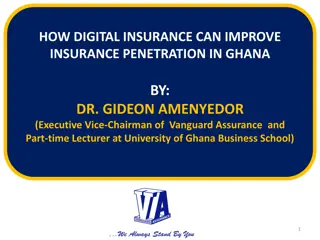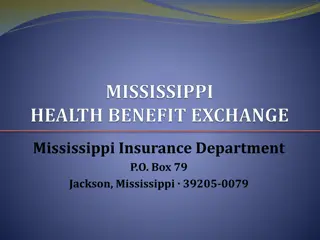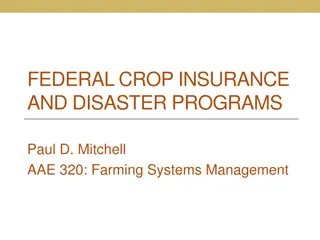Key Concepts of Insurance
Key notions of insurance include fortuitous loss, risk occurrence, loss exposure, objective and subjective risk, and the law of large numbers to predict future loss experience. Objective risk is based on actual loss variation, while subjective risk is based on individual perception. Understanding these concepts is crucial for assessing and managing risks effectively in the insurance industry.
Download Presentation

Please find below an Image/Link to download the presentation.
The content on the website is provided AS IS for your information and personal use only. It may not be sold, licensed, or shared on other websites without obtaining consent from the author.If you encounter any issues during the download, it is possible that the publisher has removed the file from their server.
You are allowed to download the files provided on this website for personal or commercial use, subject to the condition that they are used lawfully. All files are the property of their respective owners.
The content on the website is provided AS IS for your information and personal use only. It may not be sold, licensed, or shared on other websites without obtaining consent from the author.
E N D
Presentation Transcript
Fortuitous unexpected by the insured and occurs as a result of chance. Fortuitous loss loss is one that is unforseen and Loss must be accidental and occur randomly.
Risk occurence of a loss. Risk is defined as uncertainty concerning the Sometimes situations where the probabilities of possible outcomes are known or can be estimated with some degree of accuracy (risk where such probabilities cannot be estimated (uncertainty it is distinguished between risk) and situations uncertainty).
LOSS circumstance in which a loss is possible, regardless of whether a loss actually occurs. LOSS EXPOSURE EXPOSURE any situation or
Objective variation of actual loss from expected loss. Objective risk risk ( (degree degree of of risk risk) ) the relative Objective risk declines as the number of exposure increases. The law of large numbers.
The law of large numbers enables insurers to predict future loss experience. In probability theory, the law describes the result of performing the same experiment a large number of times. According to the law of large numbers, the average of the results obtained from a large number of trials should be close to the expected value, and will tend to become closer as more trials are performed. law of of large large numbers numbers is a theorem that As actual experience As the actual experience. . the number loss number of loss of exposure experience exposure units experience units increases will increases, , the approach the more the more closely expected closely the expected the loss will approach the loss
Subjective based on a person s mental condition or state of mind. Subjective risk risk ( (perceived perceived risk risk) ) uncertainty The depending on the individual. impact of subjective risk varies
Chance of will occur; not to be mistaken with risk. Chance of loss loss the probability that an event Objective relative frequency of an event based on the assumptions observations and of no change in underlying conditions. Objective probability probability refers to long-run of an infinite number of Subjective personal estimate of the chance of loss. Subjective probability probability is the individual s
For most insurance lines it is impossible to assess the true probability and severity of loss. Therefore, estimates of both the average frequency and the average magnitude of loss must be based on previous loss experience.
Peril e.g. fire, earthquake, flood, tornado, hail, lightning, car accident, burglary, etc. Peril is defined as the the cause cause of of loss loss. Hazard increases is a condition thet feeds the cause of loss. Hazard is a condition increases the condition that the frequency that creates or severity creates or severity of or frequency or of loss loss. . It
There contribute to the loss caused by perils that are coverd under an insurance policy: Physical Moral Morale hazard ( Legal hazard are four types of hazard which Physical hazard Moral hazard Morale hazard (attitudinal Legal hazard hazard hazard attitudinal hazard) hazard)
Physical increases the frequency or severity of loss. Physical hazard hazard physical condition that Examples: broken stair step, worn tyres, wet or icy road, defective wiring, defective lock, lack protection, etc. of burglar alarm, inadequate fire
Moral hazard involves dishonest intent or exposure to dishonest persons. It can be defined as dishonesty or character defects in an individual that increase the frequency or severity of loss. Examples: embezzlement, arson, faking an accident, inflating the amount of claim, etc. submitting a fraudulent claim,
Morale laziness or indifference to a loss, which increases the frequency or severity of a loss. Morale ( (attitudinal attitudinal) ) hazard hazard is carelessess, Examples: leaving car keys in an unlocked car, leaving a door unlocked, carlessness of a driver, smoking where prohibited, removing guards from machinery, not wearing safety equipment, etc.
Legal legal system or regulatory environment that increase the frequency or severity of loss. These are the conditions brought about by statute, judicial decision or administrative regulation exposure that has not existed before. Legal hazard hazard refers to characteristics of the which create potential loss Examples: decision of public authority to remove a certain product from a market, etc.
Pure and speculative risk Diversifiable risk and nondiversible risk Enterprise risk Systemic risk
Pure the possibilities of loss or no loss. Pure risk risk situation in which there are only Speculative profit or loss is possible. Speculative risk risk situation in which either
Diversifiable particular risk) is a risk that affects only individuals or small groups and not the entire economy. eliminated by diversification. Diversifiable risk risk (nonsystematic risk, This risk can be reduced or Nondiversifiable risk that affects the entire economy or large numbers of persons or groups within the economy. It cannot be eliminated or reduced by diversification. Nondiversifiable risk risk (fundamental risk) is a
Enterprise major risks faced by a business firm. Such risks strategic risk, operational risk and financial risk. Enterprise risk risk is a term that encompasses all include pure risk, speculative risk,
Systemic entire system or entire market due to failure of a single entity or group of entities that can result in the breakdown of the entire financial system. Systemic risk risk is the risk of collapse of an
Personal Property Liability Commercial Personal risk Property risk Liability risk Commercial risk risk risk risk risk
Premature death Poor health Unemployment
Risk of having property damaged, destroyed or stolen. Direct physical damage, destruction or theft of the property. Direct loss loss financial loss that results from the Indirect indirectly from the occurance of a direct physical damage or theft loss. Indirect consequential consequential loss loss financial loss that results
In major law regimes you can be held legally liable for your behaviour that results in bodily injury or property damage to someone else. Special rules on professional misconduct (malpractice) if you are a physician, attorney, accountant, etc. Special rules on liability on a defective product. No No maximum maximum upper upper limit on limit on the the amount amount of of the the loss loss. .
Property risks Liability risks Loss of business income Identity theft Cybersecurity Other risks Human resources exposures Foreign loss exposures (especially foreign currency operations) Intangible property exposures (goodwill and IP rights) Government exposures
Risk frequency or severity of losses (avoidance, loss prevention, loss reduction). Risk control control techniques that reduce the Risk the noninsurance transfers of risk, insurance). Risk financing financing techniques that provide for funding of losses (retention,
